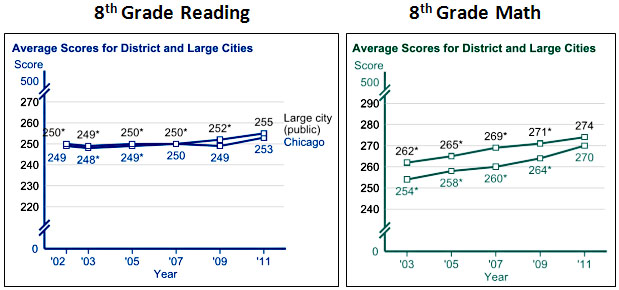Joe Nocera comments today on the teacher strike in Chicago:
There really isn’t much evidence that introducing choice and competition — an important rationale for charter schools — has forced the big-city public schools to improve. Until somebody figures out how to create reforms that work for all, and not just the lucky few, American public education will continue to suffer….Students in other countries now regularly outperform American students. We are truly in the midst of an education crisis — one that won’t be solved until we completely rethink the way we offer public education.
Is it true that big-city schools have failed to improve? There’s plenty of evidence that American students in general are doing better today than they did 30 years ago — you can see my brief overview of the raw NAEP data here — but as it happens, there’s also evidence specific to big-city schools. It’s called the Trial Urban District Assessment and it hasn’t been running as long as the main NAEP. However, it’s been running for about a decade and has now collected enough data to show us some trends. Here’s the data for Chicago in reading and math:

As you can see, test scores both in Chicago and in urban schools generally have risen over the past ten years. Scores for fourth graders have increased even more dramatically. More here.
As for whether we’re falling behind the rest of the world, I don’t know. The data is frustratingly mixed on this subject, and long-term data barely exists. My best take, however, is that nothing much has changed. The United States has always performed above average (compared to other industrialized countries) but only by a little bit, and that still seems to be true. I don’t think there’s been much upward or downward movement over the past few decades.
As usual, I don’t have any special comment to make about this. Maybe this improvement is a statistical mirage. Maybe it’s real but we should be doing even better. But whatever you think, it should be based on the best data we have. And this is it.
For more on the Chicago teacher strike itself, check out Dana Liebelson’s explainer here. It will answer most of your basic questions.













